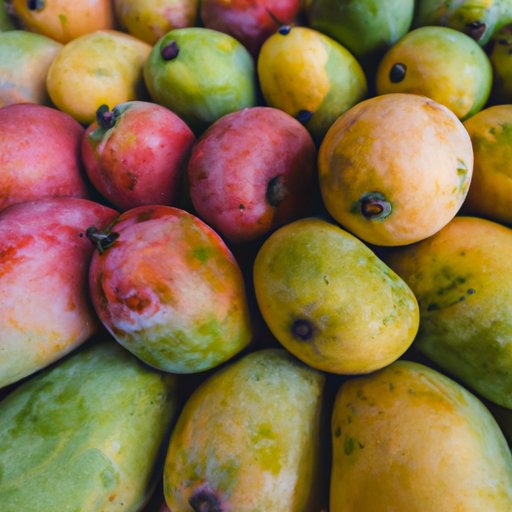
Introduction
Are you tired of struggling to choose the perfect mango at the grocery store? Look no further! This article is a comprehensive guide to choosing the juiciest, freshest and most delicious mangoes.
“5 Tips for Choosing the Perfect Mango: A Guide for Fruit Lovers”
Mangoes are delicious and versatile tropical fruit, but picking the perfect one can be quite challenging. Here are five easy tips to ensure you choose the ideal mango every time.
Tip 1: Look for a Smooth, Unblemished Skin
The first thing to check for is a smooth skin without any blemishes or scratches. This indicates that the mango is in good condition and has not been damaged during transport or storage.
Tip 2: Check for Firmness
A ripe mango should be slightly firm when you gently press the skin. Avoid choosing mangoes that are too soft or too hard. Unripe mangoes can taste sour and woody, while overripe ones can be mushy and too sweet.
Tip 3: Smell the Mango
The aroma of a mango is an excellent indicator of its ripeness. The fruit should have a sweet, fruity, and fragrant smell when it’s ready to eat.
Tip 4: Consider Mango Varieties
There are many types of mangoes available, each with unique flavors and textures. Some of the most popular varieties include Honey Mangoes (Ataulfo), Haden, and Tommy Atkins. Do a little research on the different types of mangoes and choose the one that you prefer.
Tip 5: Learn the Seasonal Availability of Mangoes
Mangoes are available all year round but are in their peak season from April to August. During this time, you can expect to find the juiciest and freshest mangoes in the market.
“From Firm to Fragrant: How to Select Mangoes like a Pro”
Explanation of the color and texture of a mango
The color and texture of mangoes can vary depending on the variety. Most ripe mangoes have a yellow-orange skin and juicy flesh. The skin should be free of any blemishes and the fruit should feel heavy for its size.
Importance of ripening process while purchasing a mango
If you want to enjoy your mangoes soon after buying them, choose fruit that is already ripe or almost ripe. However, if you prefer to store them for a few days, select mangoes that are still firm and not quite ripe yet.
Different ways to ripen a mango at home
You can ripen mangoes at home using different methods. One simple method is to place the mangoes in a paper bag and keep them at room temperature until they are ripened. Alternatively, you can keep them in a fruit bowl with other ripening fruits such as bananas or apples to speed up the process.
“The Freshness Test: How to Pick a Mango that is Ripe and Ready to Eat”
Squeeze Test to check if the fruit is ripe
Gently squeezing a mango is a great way to test its ripeness. Mangoes that are ready to eat should be slightly soft to touch without being too mushy.
The Eye Test to see internal freshness
Check if the stem of the mango is firm and green, indicating that the fruit is fresh and undamaged. You can also inspect the fruit’s flesh by cutting into it with a sharp knife. The flesh of a ripe mango should be yellow-orange, juicy, and free of any brown spots.
Skin color and aroma test
Choose mangoes with a sweet, fruity aroma, indicating that they are ripe and ready to eat. The skin should be free of any blemishes and scratches, and the fruit should feel heavy for its size.
“Picking the Best Mango: A Simple Guide to Finding the Juiciest Fruits”
Importance of choosing the fruit that suits the requirement
Mangoes are a versatile fruit that can be used in many sweet and savory dishes. Depending on how you plan to use them, you may want to choose different varieties or ripeness levels.
How to choose mangoes based on dishes
If you want to make smoothies or puree, it’s best to choose ripe or overripe mangoes. Firmer mangoes are better suited for mango salsa or fruity salads.
How to Store Mangoes to retain freshness
Once you’ve selected your mangoes, store them in a cool, dry place, such as the fridge’s crisper drawer. Depending on their ripeness level, they can last for up to five days. You can also freeze sliced mangoes for longer storage.
“Mastering the Art of Mango Selection: Expert Advice for Top-Quality Fruit Every Time”
Expert’s views about selecting the mangoes
According to experienced fruit specialists, the best mangoes come from smaller, family-owned farms where the fruit is allowed to ripen naturally on the tree. These mangoes are typically more flavorful and healthier than those that have been rushed to ripen.
Expert advice for choosing mangoes
When choosing mangoes, always go for the ones that look the freshest and have the most enticing aroma. Once you get comfortable with selecting ripe mangoes, try experimenting with different types and varieties to discover your favorites.
Personal Experiences of expert in choosing mangoes
Many seasoned fruit professionals have their methods of choosing mangoes that work best for them. Some rely on the squeeze test, while others prefer to smell the fruit to identify ripeness. Experiment with different methods and see what works best for you.
Conclusion
Choosing the perfect mango can be a tricky task, but with these simple tips, you can be sure to select the juiciest, freshest, and most delicious fruit every time. Next time you’re at the grocery store or farmer’s market, put your new knowledge to the test and enjoy your tasty mangoes.
Remember to choose mangoes that match your preferences and needs and consider their ripeness level based on how you plan to use them.




